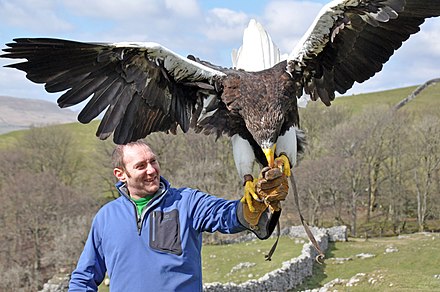Steller’s sea eagles (Haliaeetus pelagicus) are indeed monogamous and form long-lasting pair bonds. These majestic birds spend much of their time alone, but during the breeding season, they come together to build nests and raise their offspring.
Courtship and Breeding Behavior
Steller’s sea eagles typically engage in courtship rituals between February and March. This involves a soaring flight above their breeding territory, where the birds display their impressive size and strength. Once a pair has formed, they work together to build several aeries (nests), but only one will be used for raising their chicks.
The eaglets that hatch are altricial, meaning they are born covered in whitish-down and are dependent on their parents for care and feeding. The young eagles fledge (take their first flight) in August or early September, but they do not typically begin breeding themselves until they are one or two years old.
Habitat and Distribution
 Image source: stellers sea eagle
Image source: stellers sea eagle
Steller’s sea eagles are native to the eastern regions of Russia, specifically the Sea of Okhotsk and the Kamchatka Peninsula. They are also frequent winter migrants to the Japanese islands of Kuril and Hokkaido. These birds prefer to breed along sea coasts or near large rivers, where they can find mature trees or rocky outcroppings to build their nests.
Feeding Habits
As apex predators, Steller’s sea eagles feed primarily on fish, but they also prey on smaller water birds, young seals, carrion, and occasionally small mammals. Their massive size, with females weighing up to 20 pounds and males weighing around 11-13 pounds, allows them to tackle a wide range of prey.
Threats and Conservation
Steller’s sea eagles face several threats to their survival, including habitat alteration, industrial pollution, and overfishing, which can decrease their prey source. Additionally, recent heavy flooding, potentially caused by global climate change, has led to almost complete nesting failure for eagles nesting in Russian rivers, as they struggle to capture the essential fish needed to feed their nestlings.
Despite these challenges, conservation efforts are underway to protect this magnificent species. Organizations like the Denver Zoo and the Animal Diversity Web are working to raise awareness and support research and conservation initiatives for Steller’s sea eagles.
Conclusion
In summary, Steller’s sea eagles are indeed monogamous birds that form long-lasting pair bonds. They engage in courtship rituals, build nests, and raise their young together, demonstrating the strong social and familial bonds that are characteristic of this species. While they face various threats to their survival, ongoing conservation efforts aim to protect these impressive apex predators and ensure their continued presence in the wild.
References:
– Animalia.bio – Steller’s Sea Eagle
– Denver Zoo – Ursula
– Animal Diversity Web – Haliaeetus pelagicus

